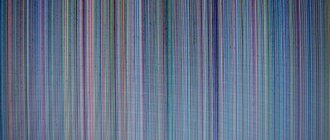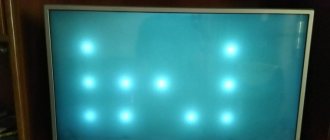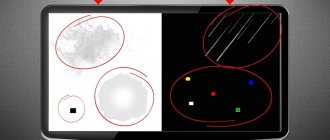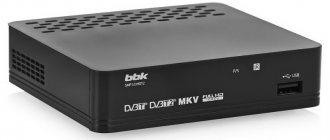Modern TV technology pleases with a clear and realistic picture, but, just like in the case of old analog TVs, it is burdened with its own specific problems. One of the most common troubles is the appearance of spots: black, light or colored.
All this clearly does not contribute to a comfortable viewing of the content, indicating a malfunction of the equipment. Let's look at the reasons for the appearance of stains, the consequences and consider options for solving such problems. The information will be relevant for plasma, LCD and LED TVs.
How to remove dark spots
“Ragged” bright spots on a dark-colored TV, located almost all over the screen, indicate a malfunction of the polarizer or diffuser, which is located in the body of the matrix. Only a specialist who has the appropriate tools and equipment can independently eliminate such a defect.
Dark spots on the LCD TV screen of a regular shape - round or oval, with decreasing intensity closer to the edges of the figure, are most likely caused by dust getting into the matrix . Most often this happens due to sudden temperature fluctuations. The layers of the matrix begin to move, and dust particles penetrate into the vacated space.
But sometimes the reason for the ingress of foreign particles can be design flaws. The latter are quite often observed on ultra-budget models from little-known companies. But large manufacturers also make mistakes. For example, Samsung recalled a whole series of unsuccessful models that literally sucked up dust and other dirt with their ventilation system. Before purchasing, it would definitely be a good idea to read reviews about a particular TV model, regardless of the reputability of the manufacturer.
In a good half of cases, you can remove such stains on your own.
- Place the TV on a soft surface with the back side facing up.
- Unscrew the screws securing the rear wall and carefully remove it.
- Using a vacuum cleaner set to blow, or a compressed air cylinder, we blow through all the edges of the matrix, directing the air stream at an angle.
- We wait 5-10 minutes and put the TV cover back in place.
Important! During blowing, it is necessary to prevent jamming of the edges of the matrix. If the air flow is too strong, then during the procedure the instrument must be moved some distance away.
If the black spot from the dust that has penetrated inside is very small, then you can try to get rid of it in an easier way. Take a dry soft cloth and, wrapping it around your finger, tap on the screen. Small particles should fall off.
On a plasma TV, such problems can be solved, alas, in only one way - calling a technician to your home or going to a service center. In this case, you cannot remove black spots on your own. This requires expensive equipment and special tools.
Why do spots appear on the screen?
First, let's look at the general problems that are common to all modern TV equipment, regardless of its type. Fortunately, there are much fewer of them than on old analog TVs, because only one element, although quite complex, is responsible for correct visualization - the matrix.
Manufacturing defects
This is true not only of budget models, but even of premium models from famous brands – Samsung, LG, Philips and others.
Advice! The only option to avoid manufacturing defects is to carefully check the equipment at the time of purchase.
Almost every firmware has special software - grids aimed at identifying dead pixels (black and white dots), spots and other defects. If a manufacturing defect was discovered at home when purchasing through an online store, the seller is in any case obliged to replace the product.
Physical damage
Pressing or hitting the TV screen hard may cause colored spots to appear. Moreover, dead pixels can spread to the rest of the matrix, which is typical for budget models where there is no independent protection for each sector. This kind of damage excludes any repairs - only matrix replacement.
Moisture and air getting into the matrix
This may involve a violation of transportation rules by the seller or improper operation of the equipment by the user. Even a few drops of water or dust particles that get into the body of the matrix can cause unpleasant spots to appear on the LCD TV screen.
High temperatures
If there is a heater or other strong heat source near the TV equipment, then the matrix may delaminate in LCD devices, or even stop working altogether if it is a plasma panel . In this case, small highlights appear that gradually fill the entire screen space.
The shape and color of the spots can also tell a lot about the nature of the problem, which allows you to immediately begin solving it. For example, on old analog TVs, multi-colored spots indicate excessive magnetization of the screen. To eliminate this problem, simply move the device to another place, away from electromagnetic equipment affecting it.
Yellow spots indicate that the process of matrix delamination has already begun, which is typical for budget models that have been actively used for more than 5 years. More expensive TV equipment for the most part does not have such problems.
Cleaning the surface of the protective glass of the screen
One of the reasons for the appearance of stains is the external adhesion of dirt and dust. In such a situation, there is no need to disassemble the equipment or reboot it. It is enough to wash the surface of the screen. For this:
TV repairs are 30% cheaper
than in service centers near your home
Order repairs
- Turn off the equipment. It is advisable to turn it off from the network.
- Purchase a special cleaner for cleaning LCD monitors.
- Take a soft microfiber cloth.
- Apply a small amount of product to it.
- Wash the screen without pressing hard.
It is advisable to do this treatment 2 times a week. This will prevent dust from penetrating under the body and sticking to the matrix.
How to remove stains
In most cases, it is almost impossible to repair a damaged area of the screen yourself. This requires special equipment and considerable repair skills. But before you panic, we recommend reading the following tips:
- If you still have a warranty card for the product and its period has not expired, then contact the store where you made the purchase. The product will be collected and sent to determine the cause of the malfunction. If the analysis shows that the damage is not mechanical, most likely you will receive a refund or simply be given a new product.
- If the dark spot is caused by physical impact during improper use, it is most likely that the store will refuse to return you. In this case, we do not recommend sending it for repair. The cost of repairing such a problem can almost reach the cost of the TV itself.
Advice: buy equipment only from well-known and trusted brands. These include equipment from LG, Samsung, Sony and many others.
This can have some pretty dramatic effects on the picture though, so you have to be very careful when trying this. For cloudiness, gently massaging the problem areas with soft tissue often does a good job of eliminating poor uniformity.
Let us know what's wrong with this question or answer. Not really for haze issues, that's not too much of a concern, but for edge light coming through the edge of the frame. Because it is very annoying when watching movies. It depends on what it looks like.
I obviously can't notice the haze with full-length images, but it's subtly noticeable in dark movie scenes with a black border at the top and bottom. I'm mainly wondering if a higher quality display would have a similar trait. From your first picture it's not that bad.
Impact stain
Dark spots on the TV are signs of mechanical damage. Such defects appear if the TV device has been dropped or the display has been hit or suffered a strong mechanical impact. The spots have very clear contours.
Internal heating of the TV aggravates the breakdown. Because neighboring pixels are also damaged. It is impossible to repair the display of a Samsung or LG TV; contact the service center and have the technicians change the matrix. However, this is also a financially expensive procedure.
If dark spots appear on the screen of a plasma or LCD TV caused by mechanical damage, it is more rational to buy new equipment. Repairs will cost approximately 50% of the nominal cost of the TV.
Manufacturing defects
If the screen works, but a bright glow appears, then this is the first sign indicating a manufacturing defect. The matrix is faulty. If the TV is still under warranty, it is better to exchange it. Because repairs are too expensive.
The defect does not appear immediately. A bright glow occurs after repeated heating. The specificity of the failure is that the geometry of the matrix layers is disrupted. The cause of the malfunction was incorrect installation of the diffuser and reflector.
If a dark spot appears on the screen, this may also indicate a manufacturing defect. At first, the defect appears in the form of small dots. This symptom indicates non-compliance with screen installation technology in production.
Small white spots on the TV screen gradually darken over time, and their size also increases. Contact the service center so that the technicians can repair the faulty device or replace the damaged matrix.
What to do if the warranty period has expired? If you use a TV from a famous brand: Samsung, Sony, LG, then it is possible that the company will want to preserve its reputation and will meet you halfway. However, such a scenario is only possible if there was no mechanical damage to the TV and the rules for caring for equipment were followed.
We should also talk about the availability of software for restoring dead pixels. However, the use of special software will be justified only if the subpixels are not damaged.
How to Get Rid of Dark Spots Due to Moisture Penetration
If a defect appears due to water ingress, you need to rinse the matrix. This will require a special detergent. Running water is not suitable. It contains a large number of invisible impurities, abrasive particles that will settle on the matrix and make the situation even worse.
Cleaning to remove dark spots from the TV matrix must be done in a well-ventilated area with good ventilation. It is advisable to turn on a humidifier if you have one. Cleaning should be done with soft cotton gloves.
Important! If the matrix is broken, it must be replaced. And this can only be done in a professional workshop or service center.
If you wish, you can carry out the replacement yourself if you have skills in working with household television appliances. The repair instructions are as follows:
- Prepare your work area and all the necessary screwdrivers and other tools.
- Turn off the power to the TV. Using a screwdriver, remove all bolts to remove the housing.
- Disconnect the wires and cables. This must be done as carefully as possible. If the connecting elements are damaged, they will also have to be replaced.
- Unscrew the bolts holding the matrix. Carefully remove it and install a new one.
- Reassemble the TV in reverse order. Turn it on and check if it works properly.
Important! If the TV is still under warranty, you do not need to disassemble it yourself. After any intervention by you, the warranty card will no longer be valid. And the repair will be carried out for you free of charge or at a big discount at the service center.
Liquid stains
It is extremely easy to distinguish between a stain on a TV screen caused by excessive amounts of liquid and a darkening caused by dust. Defects appear if alcohol, tea, coffee, juice or ordinary water gets on the display.
What to do if such spots appear on the display? Rinse the screen with boiled water (room temperature) or purified alcohol.
Stains caused by liquid are eliminated in a room without dust and drafts. Be sure to wash the display while wearing gloves to avoid further damage.
What are the alternatives?
The fear of receiving a copy with highlights forces many buyers to consider alternative options and models that are completely devoid of this drawback. Luckily they are! These are TVs equipped with OLED matrices.
In screens built on organic diodes, there is no backlight module in principle, since the matrix itself consists of many multi-color LEDs (one for each pixel of the image), each of which is an independent light source.
The disadvantages of this solution include the high cost of the screen, and, consequently, the product itself, and the relatively short life cycle of organic LEDs. They degrade and fade (elements that form blue color are especially susceptible to this scourge), which over time leads to fading of the image and permanent loss of a pixel.
LCD TVs
Liquid crystal TVs, or LCD TVs, are especially widely represented on the market. They are produced by almost all well-known brands, including Sony, Philips, Samsung and LG.
LCD TVs have a complex LED system that can be easily damaged by careless actions. Therefore, these devices are susceptible to various image defects, including:
- "color negative";
- complete or partial disappearance of any color;
- predominance of a specific color;
- dimming at the edges of the screen and more.
Color negative
The unnatural colors of the TV make it look like a thermal imager. Often this defect appears some time after turning on the TV and progresses.
Green faces and red grass may indicate:
- firmware failure;
- matrix malfunction: for example, the timing controller (T-con board) has failed;
- loss of contact with the control panel or other systems;
- incorrect operation of the antenna.
In the first case, it is recommended to update the software; in the remaining cases, contact a technician. Our specialists will carry out comprehensive diagnostics, perform repairs or replace faulty parts with original spare parts.
Disappearance of color
As a rule, one of the three primary colors - red, green or blue - disappears partially or completely. The distorted color of the TV can be correlated with a specific breakdown. In most cases, the video amplifier or color block is faulty. Chips may also need to be replaced.
Predominance of one color
The appearance of dominant colors indicates damage to the color adjustment board, which is responsible for the correct display of the palette. The unit could fail due to overheating or poor contact of the elements. You should urgently call a specialist, otherwise the device may completely lose its functionality.
Dimming at the edges of the screen
Blackouts on the left and right sides, as well as in other areas of the display, indicate a malfunction of the monitor's backlight system. The following reasons are possible:
- failure of the backlight module (high-voltage converter);
- burnout of the lamp in the matrix due to a manufacturing defect or power surge;
- mechanical damage to the lamp;
- failure of the inverter driver (if the center of the screen is darkened).
It is better to entrust diagnostics and repair of the unit to a specialist. It is necessary to first inform the brand and model of the television receiver so that the technician will bring all the necessary parts from the warehouse.
Dark spot on LCD monitor
A black spot on the monitor occurs for the same reasons as dark spots on the TV. An LCD monitor has the same structure as a TV and differs only in screen size.
One of the most common problems is that light or dark areas are visible after replacing LEDs. In such cases, a spot on the TV screen occurs when dust gets on the matrix.
They also occur due to mechanical damage and manufacturing defects.
Dust and small debris
White spots on an LCD TV screen occur as a result of dust particles penetrating into the layers of the matrix. This also indicates non-compliance with the geometry of the layers. Regular temperature fluctuations (the TV constantly heats up and then cools down) lead to movement of the layers. Because of this, dust and other small debris gets into the layers of the matrix. After 2-3 months, black dots or a large black spot may appear.
Experts strongly recommend wiping the LCD display promptly. It is not necessary to use special wet wipes or special aerosols. The best way to remove dust is blowing. This eliminates the possibility of damage to the matrix.
Not only dust can get stuck between the layers of the matrix. It is possible that larger particles will also be there. There are cases when insects get stuck between the layers. However, this is rather an exception, indicating a manufacturing defect.
Large dust particles and other contaminants are removed as follows:
- Take a dry and soft cloth.
- Tap the display lightly.
- The dust particles will gradually fall off.
Why can't you just wipe the screen? Firstly, stains may appear, which are extremely difficult to get rid of in the future. Secondly, if the geometry of the layers is truly broken, then wiping will only worsen the problem.
To prevent dust from getting stuck between the layers of the LED TV, you need to lightly knock on the center of the display. Tapping the edges may make the problem worse.
Malfunctions of liquid crystal models
LCD TVs have several large boards installed - a motherboard and a power supply. To find out what is wrong, a small test is required - press the start button.
If you can turn on the TV, then the problem lies with the board. Most likely, the breakdown occurs when the processor contacts peel off from the board. A space appeared between them, and as a result the image was deteriorated. To fix the problem, you need to buy a new board or the TV itself. It is important to understand that replacing the board will be very expensive, since the repair process includes diagnostic work, as well as the repair itself.
Knowing the causes of the malfunction and the appearance of the green color, you can understand why the TV failed, and how much the repair will cost, as well as whether it makes sense to repair your device.
Recommendations for troubleshooting
Let's start with a few preventative tips that will help avoid various defects appearing on the TV screen:
- Never spray water on the LCD display or wipe it with a wet cloth. Moisture can cause the contacts to short circuit. Use special care products that are sold in electronics stores.
2. You should not carry the TV or move it every day. This may cause damage to the cable and connectors, which will lead to various defects. It is important that the device is securely fastened, because mechanical damage will cause failure of the hardware modules.
3. Dust and dirt particles must not accumulate on the TV. All this can contribute to overheating of the cable, as a result of which the contacts are deformed. The best way to get rid of dust is by blowing. You can use a vacuum cleaner for this.
We've sorted out the prevention. Now he will analyze how to remove an existing defect. The specifics of the repair directly depend on what kind of breakdown we are talking about.
Problems with contact
As it was found out earlier, vertical stripes on the Philips TV screen may appear due to poor contact. Such breakdowns occur due to low-quality assembly of the TV. It is possible that the user did not comply with the operating conditions of the equipment. For example, even cleaning the screen incorrectly can lead to defects.
How can you determine that contact problems are the catalyst for streaking? A visual inspection is sufficient. Violations in connections are visible to the naked eye. If necessary, magnifying devices can be used.
What to do if the contacts are oxidized? Cleaning can be done with a blade, knife or any other sharp tool at hand. Oxidized contacts are places with a green coating, but if the scale of the problem is excessively large, then fixing the damage will be very difficult. Once you have removed the plaque, you need to check the voltage. Be sure to test the contacts with a multimeter.
Poor contact is also a consequence of improper connection of the cables. If this is the reason, then all the loops are disconnected and then reconnected.
A break in the matrix cable is another reason for the appearance of stripes on the TV screen. This failure is determined very simply. You need to apply a little pressure or move the train. If the defects disappear, then the failure has been diagnosed correctly.
To correct the situation, you need to take a magnifying glass and then find the place where the cable wires are damaged. This will not be easy to do. Such repairs are very painstaking and exquisite work. Restoration is carried out using conductive varnish or by heating the contacts to a moderate temperature. Overheating may make the problem worse.
Replacing the cable
Sometimes not only the wiring is damaged, but the entire cable is damaged. This means that this part will have to be replaced. First, you need to purchase a new, preferably original, component. You can order the necessary spare parts from workshops, but first you should find out the model and year of manufacture of the TV.
You can replace a damaged cable yourself, but it is better to take the TV to a workshop. To carry out such repairs you will need professional equipment. Using improvised means will worsen the breakdown.
The matrix cable is a hardware connecting element. Therefore, to remove the component, you will have to unscrew the TV and remove some parts.
Absolutely all manufacturers use standard fasteners. Therefore, it is necessary to unscrew the bolts counterclockwise. Please note that sometimes connecting cables and wires are attached directly to the cover. When disassembling the TV, remove all parts smoothly so as not to damage anything.
Mostly the connecting elements are attached using special connectors. Therefore, there is no need to solder the wires. To remove the cable, simply press down on the latch. The connection principle is similar to an Ethernet cable.
The design of TV devices from different manufacturers will differ. Therefore, follow the instructions. You can order assembly details on the manufacturer's official website.
Damage to the matrix and its components
The presence of such a breakdown is indicated by a vertical stripe that appears on the TV screen. Such a defect may occur due to mechanical damage or a short circuit. Sometimes the stripes disappear after a few days. If about a week has passed and the defects have not disappeared, this is a serious problem.
Replacing the matrix yourself is extremely difficult. Therefore, such repairs must be carried out at a service center. However, such a service can cost up to 70% of the price of the TV. Based on this, you first need to find out the cost of restoration, and only then agree to repairs. It is possible that maintenance will be unprofitable.
If thin black lines appear, this indicates a breakdown of the decoder, which is located directly on the matrix. Gradually the size of the line will increase. Therefore, do not delay the repair. Contact the service center, especially if the warranty is still valid.
Users who decide to independently replace the matrix or its components need to take into account several extremely important details:
- For the most part, all conductors are very miniature, their diameter is minimal. There is a high probability that you will break one of the conductors.
- To repair or re-solder contacts, you need to have the appropriate skills and professional equipment: an infrared soldering station, magnifying devices, etc.
- Repairs must be carried out as carefully as possible. Any unnecessary movement can cause problems to worsen.
Streaks and other defects can appear on the TV screen as a result of both minor and large-scale breakdowns. Is it worth repairing your TV yourself? If we are talking about stripping the cable, then you can try. However, it is still better not to replace hardware modules. There is too high a risk that you will only make the problem worse. It is wiser to contact a service center.
TV shows red picture
If your TV shows red, check your settings. Common human factors often cause problems. You probably accidentally increased the red saturation.
Sometimes the source of trouble is the antenna. The signal arrives from the satellite in normal mode, then is transmitted from the antenna to the TV incorrectly. It can distort colors, the picture disappears, and so on. Failure is characterized not only by a loss of quality, but also by associated failures (streaks, ripples or spots).
due to dust . Dust damages the surfaces of parts. Sooner or later this will lead to errors or complete failure of the equipment.
Breakdowns of a TV with a kinescope
If a green monitor appears on a TV with a kinescope, first of all you need to check the existing board. A monitor that is more than 10 years old usually becomes faulty. It is necessary to periodically call a specialist so that he can eliminate problems in the early stages of their occurrence.
But there are also other possible causes of a green TV screen that will have to be eliminated:
- The cathode with the modulator is closed.
- The transistor is damaged.
- Capacitor leak. The first thing to replace is the capacitor.
- The microcircuit itself has failed.
- The cathode is incapable of emission. In this case, the screen color will change.
To check a transistor, use a voltage measurement at its output. If a breakdown occurs, the indicator will be equal to 0.09 kilovolts. The TV screen on the TV becomes altered due to a broken capacitor. It will have to be replaced. There may be other reasons, but if all else fails, you still need to check the capacitor. When the TV is old and more than 10 years old, the emission in the cathodes decreases. In this case, color loss is an expected process. The intensity of application differs:
- red – 0.7;
- green – 0.2;
- blue – 0.1.
Therefore, the red one begins to disappear first, and the “green TV” will begin to predominate if the emission remains normal. In this option, “shooting” the cathodes or replacing the kinescope will help.











